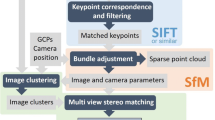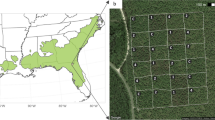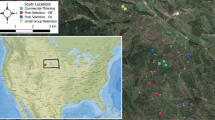Abstract
Forest ecosystems play an important role in the interaction between the land surface and the atmosphere. Measurements and modelling efforts have revealed significant uncertainties in state-of-the-art flux assessments due to spatial inhomogeneities in the airflow and land surface. Here, a field experiment is used to describe the turbulent flow across a typical Central European forest clearing. A three-dimensional model of the inhomogeneous forest stand was developed using an innovative approach based on terrestrial laser-scanner technology. The comparison of the wind statistics of two measurement campaigns (5 and 12 months long) showed the spatial and temporal representativeness of the ultrasonic anemometer measurements within the canopy. An improved method for the correction of the vertical velocity enables the distinction between the instrumental offsets and the vertical winds due to the inclination of the instrument. Despite a 13 % fraction of deciduous plants within the otherwise evergreen canopy, the effects of phenological seasons on the velocity profiles were small. The data classified according to the wind speed revealed the intermittent nature of recirculating air in the clearing. Furthermore, the development of sub-canopy wind-speed maxima is explained by considering the velocity moments and the momentum equation (including measurements of the local pressure gradient). Clearings deflect the flow downward and feed the sub-canopy flow, i.e., advective fluxes, according to wind speed and, likely, clearing size, whereas local pressure gradients play an important role in the development of sub-canopy flow. The presented dataset is freely available at the project homepage.














Similar content being viewed by others
Notes
ADVEX: The extensive experimental activities of the CarboEurope-Integrated Project (CE-IP) advection group took into account the 3D aspects of the problem.
EGER: ExchanGE processes in mountainous Regions.
CHATS: Canopy Horizontal Array Turbulence Study experiment.
UMBS: University of Michigan Biological Station in northern, lower Michigan, USA.
Project homepage: http://tu-dresden.de/turbefa.
References
Albertson JD, Katul GG, Wiberg P (2001) Relative importance of local and regional controls on coupled water, carbon, and energy fluxes. Adv Water Resour 24(9–10):1103–1118
Aubinet M (2008) Eddy covariance \({\rm CO}_2\) flux measurements in nocturnal conditions: an analysis of the problem. Ecol Appl 18(6):1368–1378
Aubinet M, Vesala T, Papale D (eds) (2012) Eddy covariance: a practical guide to measurement and data analysis, 2012th edn. Springer, Dordrecht, 460 pp
Baldocchi D, Falge E, Gu L, Olson R, Hollinger D, Running S, Anthoni P, Bernhofer C, Davis K, Evans R, Fuentes J, Goldstein A, Katul G, Law B, Lee X, Malhi Y, Meyers T, Munger W, Oechel W, Paw KT, Pilegaard K, Schmid HP, Valentini R, Verma S, Vesala T, Wilson K, Wofsy S (2001) FLUXNET: a new tool to study the temporal and spatial variability of ecosystem-scale carbon dioxide, water vapor, and energy flux densities. Bull Am Meteorol Soc 82(11):2415–2434
Banerjee T, Katul G, Fontan S, Poggi D, Kumar M (2013) Mean flow near edges and within cavities situated inside dense canopies. Boundary-Layer Meteorol 149(1):19–41
Belcher SE, Finnigan JJ, Harman IN (2008) Flows through forest canopies in complex terrain. Ecol Appl 18(6):1436–1453
Belcher SE, Harman IN, Finnigan JJ (2012) The wind in the willows: flows in forest canopies in complex terrain. Annu Rev Fluid Mech 44(1):479–504
Bernhofer C, Aubinet M, Clement R, Grelle A, Grünwald T, Ibrom A, Jarvis P, Rebmann C, Schulze ED, Tenhunen JD (2003) Spruce forests (Norway and Sitka Spruce, Including Douglas fir): carbon and water fluxes and balances, ecological and ecophysiological determinants. Ecological studies, vol 163. Springer, Berlin, pp 99–123
Bernhofer C, Grünwald T, Spank U, Clausnitzer F, Eichelmann U, Feger KH, Köstner B, Prasse H, Menzer A, Schwärzel K (2011) Mikrometeorologische, pflanzenökologische und bodenhydrologische Messungen in Buchen- und Fichtenbeständen des Tharandter Waldes. Waldökol Landsch Nat 12:17–28
Bienert A, Maas HG (2009) Methods for the automatic geometric registration of terrestrial laserscanner point clouds in forest stands. IAPRS 38-3/W8:1–6
Bienert A, Queck R, Schmidt A, Bernhofer C, Maas HG (2010) Voxel space analysis of terrestrial laser scans in forests for wind field modelling. IAPRS 38(Part 5):92–97
Bohrer G, Katul GG, Walko RL, Avissar R (2009) Exploring the effects of microscale structural heterogeneity of forest canopies using large-eddy simulations. Boundary-Layer Meteorol 132(3):351–382
Brunet Y, Finnigan JJ, Raupach MR (1994) A wind tunnel study of air flow in waving wheat: single-point velocity statistics. Boundary-Layer Meteorol 70(1):95–132
Cassiani M, Katul GG, Albertson JD (2008) The effects of canopy leaf area index on airflow across forest edges: large-eddy simulation and analytical results. Boundary-Layer Meteorol 126(3):433–460
Damschen EI, Baker DV, Bohrer G, Nathan R, Orrock JL, Turner JR, Brudvig LA, Haddad NM, Levey DJ, Tewksbury JJ (2014) How fragmentation and corridors affect wind dynamics and seed dispersal in open habitats. Proc Natl Acad Sci USA 111(9):3484–3489
Detto M, Katul GG, Siqueira M, Juang J, Stoy P (2008) The structure of turbulence near a tall forest edge: the backward-facing step flow analogy revisited. Ecol Appl 18(6):1420–1435
Dupont S, Brunet Y (2008) Edge flow and canopy structure: a large-eddy simulation study. Boundary-Layer Meteorol 126(1):51–71
Dupont S, Bonnefond JM, Irvine MR, Lamaud E, Brunet Y (2011) Long-distance edge effects in a pine forest with a deep and sparse trunk space: in situ and numerical experiments. Agric For Meteorol 151(3):328–344
Eysn L, Pfeifer N, Ressl C, Hollaus M, Grafl A, Morsdorf F (2013) A practical approach for extracting tree models in forest environments based on equirectangular projections of terrestrial laser scans. Remote Sens 5(11):5424–5448
Feigenwinter C, Bernhofer C, Vogt R (2004) The influence of advection on the short term \(\text{ CO }_{2}\)-budget in and above a forest canopy. Boundary-Layer Meteorol 113(2):201–224
Feigenwinter C, Bernhofer C, Eichelmann U, Heinesch B, Hertel M, Janous D, Kolle O, Lagergren F, Lindroth A, Minerbi S, Moderow U, Mölder M, Montagnani L, Queck R, Rebmann C, Vestin P, Yernaux M, Zeri M, Ziegler W, Aubinet M (2008) Comparison of horizontal and vertical advective \(\text{ CO }_2\) fluxes at three forest sites. Agric For Meteorol 148(1):12–24
Finnigan JJ (2000) Turbulence in plant canopies. Annu Rev Fluid Mech 32:519–571
Finnigan JJ, Belcher SE (2004) Flow over a hill covered with a plant canopy. Q J R Meteorol Soc 130(596):1–29
Flesch TK, Wilson JD (1999) Wind and remnant tree sway in forest cutblocks. I. Measured winds in experimental cutblocks. Agric For Meteorol 93(4):229–242
Foken T, Aubinet M, Finnigan JJ, Leclerc MY, Mauder M, Paw U KT (2011) Results of a panel discussion about the energy balance closure correction for trace gases. Bull Am Meteorol Soc 92(4):ES13–ES18
Fontan S, Katul GG, Poggi D, Manes C, Ridolfi L (2012) Flume experiments on turbulent flows across gaps of permeable and impermeable boundaries. Boundary-Layer Meteorol 147(1):21–39
Frank C, Ruck B (2008) Numerical study of the airflow over forest clearings. Forestry 81(3):259–277
Frühauf C, Zimmermann L, Bernhofer C (1999) Comparison of forest evapotranspiration from ECEB-measurements over a spruce stand with the water budget of a catchment. Phys Chem Earth Part B 24(7):805–808
Gash JHC (1986) Observations of turbulence downwind of a forest–heath interface. Boundary-Layer Meteorol 36(3):227–237
Gavrilov K, Accary G, Morvan D, Lyubimov D, Méradji S, Bessonov O (2010) Numerical simulation of coherent structures over plant canopy. Flow Turbul Combust 86(1):89–111
Grünwald T, Bernhofer C (2007) A decade of carbon, water and energy flux measurements of an old spruce forest at the Anchor Station Tharandt. Tellus B 59:387–396
Högström U, Smedman AS (2004) Accuracy of sonic anemometers: laminar wind-tunnel calibrations compared to atmospheric in situ calibrations against a reference instrument. Boundary-Layer Meteorol 111(1):33–54
Huang J, Cassiani M, Albertson JD (2011) Coherent turbulent structures across a vegetation discontinuity. Boundary-Layer Meteorol 140(1):1–22
Irvine MR, Gardiner BA, Hill MK (1997) The evolution of turbulence across a forest edge. Boundary-Layer Meteorol 84(3):467–496
Jegede OO, Foken T (1999) A study of the internal boundary layer due to a roughness change in neutral conditions observed during the LINEX field campaigns. Theor Appl Climatol 62(1–2):31–41
Kanani-Sühring F, Raasch S (2015) Spatial variability of scalar concentrations and fluxes downstream of a clearing-to-forest transition: a large-eddy simulation study. Boundary-Layer Meteorol 155(1):1–27
Lee X (2000) Air motion within and above forest vegetation in non-ideal conditions. For Ecol Manag 135(1–3):3–18
Lee X, Finnigan JJ, Paw U KT (2004) Coordinate systems and flux bias error. In: Massman W, Law B (eds) Handbook of micrometeorology, 1st edn. Kluwer, Dordrecht, pp 33–36
Liu J, Chen JM, Black TA, Novak MD (1996) E–\(\epsilon \) modelling of turbulent air flow downwind of a model forest edge. Boundary-Layer Meteorol 77(1):21–44
Maurer KD, Bohrer G, Kenny WT, Ivanov VY (2015) Large-eddy simulations of surface roughness parameter sensitivity to canopy-structure characteristics. Biogeosciences 12(8):2533–2548
Moderow U, Bernhofer C (2014) Cluster of the technische universität dresden for greenhouse gas and water fluxes. In: iLEAPS Special Newsletter issue on Environmental Research Infrastructures, pp 34–37
Moderow U, Feigenwinter C, Bernhofer C (2007) Estimating the components of the sensible heat budget of a tall forest canopy in complex terrain. Boundary-Layer Meteorol 123(1):99–120
Nakai T, van der Molen M, Gash J, Kodama Y (2006) Correction of sonic anemometer angle of attack errors. Agric For Meteorol 136(1–2):19–30
Nishiyama RT, Bedard AJ (1991) A ‘Quad-Disc’ static pressure probe for measurement in adverse atmospheres: with a comparative review of static pressure probe designs. Rev Sci Instrum 62(9):2193–2204
Otto M (2005) Vergleich unterschiedlicher Verfahren zur Abschätzung der Kohlenstoffspeicherung in einem Fichtenwald. Diplomarbeit, TU Dresden, Tharandt, 81 pp
Patton EG, Horst TW, Sullivan PP, Lenschow DH, Oncley SP, Brown WOJ, Burns SP, Guenther AB, Held A, Karl T, Mayor SD, Rizzo LV, Spuler SM, Sun J, Turnipseed AA, Allwine EJ, Edburg SL, Lamb BK, Avissar R, Calhoun RJ, Kleissl J, Massman WJ, Paw U KT, Weil JC (2011) The canopy horizontal array turbulence study (CHATS). Bull Am Meteorol Soc 92:593–611
Prescher AK, Grünwald T, Bernhofer C (2010) Land use regulates carbon budgets in eastern Germany: from NEE to NBP. Agric For Meteorol 150(7–8):1016–1025
Queck R, Bienert A, Maas HG, Harmansa S, Goldberg V, Bernhofer C (2012) Wind fields in heterogeneous conifer canopies: parameterisation of momentum absorption using high-resolution 3D vegetation scans. Eur J For Res 131(1):165–176
Queck R, Bernhofer C, Bienert A, Eipper T, Goldberg V, Harmansa S, Hildebrand V, Maas HG, Schlegel F, Stiller J (2015) TurbEFA: an interdisciplinary effort to investigate the turbulent flow across a forest clearing. Meteorol Z 6:637–659
Raupach MR, Thom AS (1981) Turbulence in and above plant canopies. Annu Rev Fluid Mech 13:97–129
Raupach M, Bradley EF, Ghadiri H (1987) A wind tunnel investigation into aerodynamic effect of forest clearings on the nesting of Abbott’s boody on christmas island. Tech. Rep., CSIRO Centre for Environmental Mechanics, Canberra, 23 pp
Raupach MR, Finnigan JJ, Brunet Y (1996) Coherent eddies and turbulence in vegetation canopies: the mixing-layer analogy. Boundary-Layer Meteorol 78(3):351–382
Rebmann C, Göckede M, Foken T, Aubinet M, Aurela M, Berbigier P, Bernhofer C, Buchmann N, Carrara A, Cescatti A, Ceulemans R, Clement R, Elbers JA, Granier A, Grünwald T, Guyon D, Havránková K, Heinesch B, Knohl A, Laurila T, Longdoz B, Marcolla B, Markkanen T, Miglietta F, Moncrieff J, Montagnani L, Moors E, Nardino M, Ourcival JM, Rambal S, Rannik u, Rotenberg E, Sedlak P, Unterhuber G, Vesala T, Yakir D (2005) Quality analysis applied on eddy covariance measurements at complex forest sites using footprint modelling. Theor Appl Climatol 80(2–4):121–141
Rudnicki M, Mitchell SJ, Novak MD (2004) Wind tunnel measurements of crown streamlining and drag relationships for three conifer species. Can J For Res 34(3):666–676
Schlegel F, Stiller J, Bienert A, Maas HG, Queck R, Bernhofer C (2012) Large-eddy simulation of inhomogeneous canopy flows using high resolution terrestrial laser scanning data. Boundary-Layer Meteorol 142:223–243
Schlegel F, Stiller J, Bienert A, Maas HG, Queck R, Bernhofer C (2015) Large-eddy simulation study of the effects on flow of a heterogeneous forest at sub-tree resolution. Boundary-Layer Meteorol 154(1):27–56
Schwärzel K, Menzer A, Clausnitzer F, Spank U, Häntzschel J, Grünwald T, Köstner B, Bernhofer C, Feger KH (2009) Soil water content measurements deliver reliable estimates of water fluxes: a comparative study in a beech and a spruce stand in the Tharandt forest (Saxony, Germany). Agric For Meteorol 149(11):1994–2006
Serafimovich A, Thomas C, Foken T (2011) Vertical and horizontal transport of energy and matter by coherent motions in a tall spruce canopy. Boundary-Layer Meteorol 140(3):429–451
Shaw R, Patton E (2003) Canopy element influences on resolved- and subgrid-scale energy within a large-eddy simulation. Agric For Meteorol 115:5–17
Shaw R, den Hartog G, Neumann H (1988) Influence of foliar density and thermal stability on profiles of Reynolds stress and turbulence intensity in a deciduous forest. Boundary-Layer Meteorol 45:391–409
Sogachev A, Leclerc MY, Zhang G, Rannik l, Vesala T (2008) \(\text{ CO }_{2}\) fluxes near a forest edge: a numerical study. Ecol Appl 18(6):1454–1469
Vosselman G, Maas HG (2010) Airborne and terrestrial laser scanning. Whittles Publishing, Dunbeath, 336 pp
Wilson JD, Flesch TK (1999) Wind and remnant tree sway in forest cutblocks. III. A windflow model to diagnose spatial variation. Agric For Meteorol 93(4):259–282
Yang B, Morse A, Shaw R, Paw U KT (2006a) Large-eddy simulation of turbulent flow across a forest edge. Part II: momentum and turbulent kinetic energy budgets. Boundary-Layer Meteorol 121:433–457
Yang B, Raupach MR, Shaw RH, Paw U KT, Morse A (2006b) Large-eddy simulation of turbulent flow across a forest edge. Part I: flow statistics. Boundary-Layer Meteorol 120(3):377–412
Yi C (2008) Momentum transfer within canopies. J Appl Meteorol Climatol 47(1):262–275
Acknowledgments
The work was supported by the German National Science Foundation (Deutsche Forschungsgemeinschaft, DFG) within the priority programme SPP 1276, ‘Multiple Scales in Fluid Mechanics and Meteorology’ (MetStröm) within the project ‘Turbulent Exchange processes between Forested areas and the Atmosphere’. We thank Dr. Christian Feigenwinter and Dr. Roland Vogt (University of Basel) for their logistical support and scientific discussions and we thank the staff of the Chair of Meteorology of the TU Dresden, namely Uwe Eichelmann, Heiko Prasse and Markus Hehn for technical support.
Author information
Authors and Affiliations
Corresponding author
Electronic supplementary material
Below is the link to the electronic supplementary material.
Rights and permissions
About this article
Cite this article
Queck, R., Bernhofer, C., Bienert, A. et al. The TurbEFA Field Experiment—Measuring the Influence of a Forest Clearing on the Turbulent Wind Field. Boundary-Layer Meteorol 160, 397–423 (2016). https://doi.org/10.1007/s10546-016-0151-z
Received:
Accepted:
Published:
Issue Date:
DOI: https://doi.org/10.1007/s10546-016-0151-z




